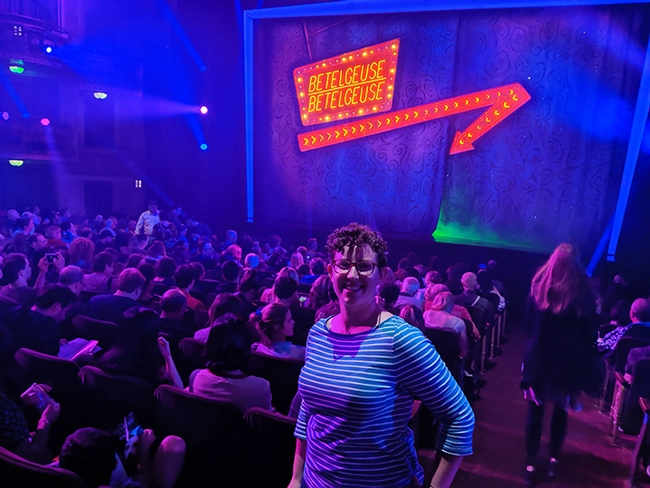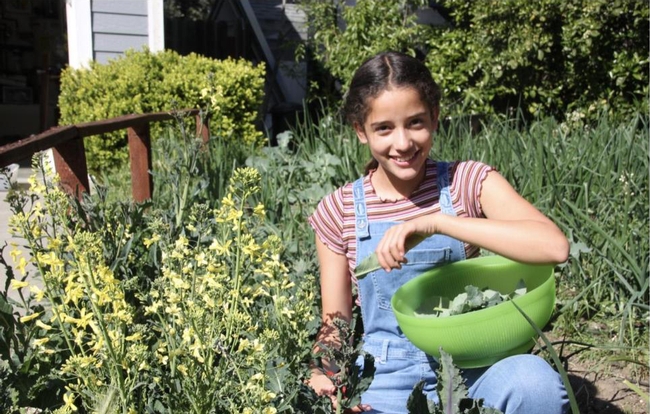- Author: Kathy Keatley Garvey
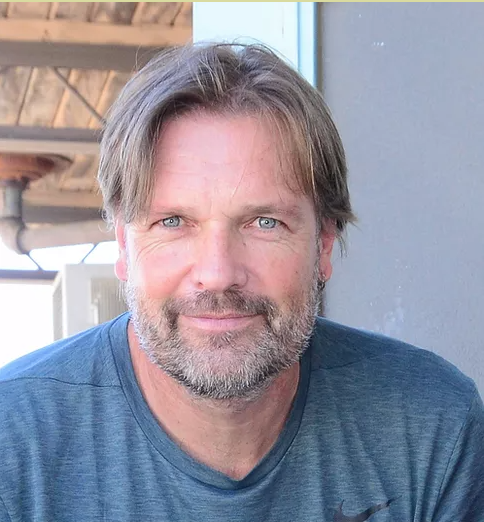
He delivered his virtual presentation in three parts: Parts 1-3 and Final Thoughts. They are now available on his website (http://chrnansen.wix.com/nansen2) as YouTube videos.
"I argue that, in the near future, we as university professors may have to look beyond publication of results in a research article--that students and society will likely demand more from us," Nansen said. "We can embrace and integrate technologies into what we do to create educational platforms, which include exposure to technologies and therefore enable students to acquire highly 'marketable' career skill sets. We can integrate discussions about entrepreneurship into our research and education--demonstrate to funding bodies, colleagues, and students that we take development and adoption of science-driven solutions seriously."
In his three-part lecture, Nansen provides examples of his research and approaches to university education.
"The lecture," he explains, "describes three elements in my program: optical sensing to diagnose insects, smartphone app development, and use of insect mass-rearing to biodegrade waste streams. Applied research, technology, innovation, and entrepreneurship are the denominators tying these three elements together."
In addition to insect ecology and remote sensing, Nansen's research interests include integrated pest management, host plant stress detection, host selection by arthropods, pesticide performance, and use of reflectance-based imaging in a wide range of research applications.
The three-part lecture:
- Introduction
- Part One: Optical or Remote Sensing
- Part Two: Smartphone App Development and Pesticide Sprays
- Part Three: Breeding of Insects to Bioconverte Waste
- Final Thoughts
Born and educated in Denmark, Nansen received his master's degree in biology from the University of Copenhagen in 1995 and his doctorate in zoology from the Royal Veterinary and Agricultural University in Denmark in 2000. He accepted positions in Portugal, Benin, United States, UK and Australia before joining the UC Davis Department of Entomology and Nematology in 2015 as an assistant professor. His international experience also includes being an international exchange student at the University of Lisbon, Portugal and a visiting professor at Northwest A&F University, Yangling, China.
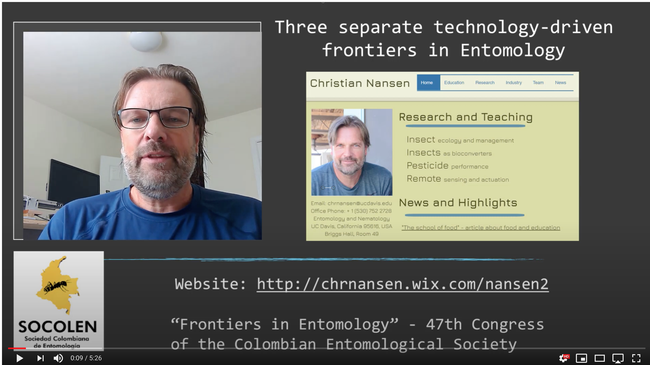
- Author: Kathy Keatley Garvey

In a newly published article on “The School of Food” in Futurum, Nansen advocates that all school curricula be “rooted in a single dominator: food.”
Biology, ecology and environmental science should be “taught based on subjects related to the growth of plants and animals,” Nansen writes. Literature, history, sociology and humanities should focus on “the importance of food concepts, like ‘breaking bread,' feasts and banquets.”
“What I am proposing here is already being done, in part, as individual initiatives and projects,” he writes. “For example, many schools have a butterfly garden, biology labs keep colonies of insects, students grow some vegetables and have a few livestock animals. In some schools, students learn how to eat and cook healthy food.”
Futurum is a website geared toward students and teachers to become inspired and interested in science. It focuses on research, analysis and insights.
Nansen, whose research interests include insect ecology, integrated pest management, and remote sensing, says that such a focus on food “would strengthen, not weaken, the academic rigor that could be delivered to students of all age groups.”
“That is, ‘food' as an educational denominator can be taught and approached with multiple goals in mind, and these would be similar to the current distinctions between practical and more theoretical classes. By engaging with students through the prism of food, we can make math, physics, history, biology, literature--all these topics more relevant to students and make the teaching more interactive and challenge-based.”
Nansen acknowledges that it is crucial that schools teach students about traditional subjects and provide them with essential skill sets regarding problem solving, critical thinking and basic knowledge, but that that students “can all be taught very effectively through an underlying emphasis on food.”
For example, he mentions that students of all ages can grow crop plants in small pots inside a classroom or outside (small plots and roof gardens), “and study growth as a function of time and growing conditions.” More advanced practical tasks could include developing irrigation systems, and plant and animal breeding programs.
Another example: for engineering, computer sciences and food production, students could delve into solar panels, rainwater catchment systems and water recycling methods. At the more advanced level, they could integrate robotics and machine learning system.
Nansen, linking chemistry with cooking, comments: “Cooking is nothing more and nothing less than applied chemistry. How does the pickling of vegetables work? What is happening when cream is whipped? What happens to food during heating and/or frying? Salting olives, fish and other types of meat has been practiced for thousands of years—how does this means of preserving food actually work?”
In his article, Nansen also explains how food can be incorporated in such subjects as humanities, human history, social studies and math.
Eating has changed over time, the professor acknowledges, “and it varies among countries and cultures, meaning that not all students view food in the same way.” But teachers can capitalize on diversity in the classroom, he relates. They can also address “societal challenges, such as obesity” and elevate levels of empowerment related to stresses, such as fear.
In the article, Nansen shared a project he assigned to his 11-year daughter, Molly, during the sheltering-in requirements: “How much cabbage would be needed to meet the Vitamin K requirements for her entire class for a whole year?”
In addition to learning about the metric system, using Excel spread sheets, regression analyses and calculus, Molly investigated websites and came to several conclusions:
- A person can harvest about 3 kg per m2 (kilograms per square meter)
- A student her age has to have 105 grams of cabbage to meet daily vitamin K requirements
In addition, she created a cabbage-muffin recipe and calculated she would need to eat four muffins per day to meet the daily Vitamin K requirements. She also calculated she would need 2,291 m2 to grow enough cabbage to meet the daily vitamin K requirement for her entire school. It is age-dependent, so that was a bit tricky to figure out.
And lastly, using Google Earth, Molly suggested where to place the cabbage field next to her school. (Her entire project is online as a sidebar.)
Virtual Youth Summit on Food and Education 2021
Nansen said he seeks contact with teachers and headmasters "interested in pursuing this approach at some level at their school."
"The idea is now to take this several steps further, through collaboration with teachers and their students, and set up a web-based platform to host an annual virtual youth summit on food and education!" he said. "That is, groups of students, in collaboration with their teachers and as part of course curricula, produce a 3-5 minute video describing a particular project they have executed. These videos would then be shown at the virtual youth summit, and we will organize review panels of students, teachers, and scientists to comment on the videos. These video projects would be divided into age groups and topics – still to be determined."
"I am hoping that we will be able to create a very special category of video projects describing two schools (have to be on separate continents) doing a project together," Nansen said. "As a start, we are pursuing the potential of a school in California working with a school in Uganda… which would be awesome!"
"We may be able to obtain corporate sponsorships and therefore be able to offer prizes/awards to participating schools, teachers and student groups. With corporate sponsorships, we may also be able to offer logistical support to schools – computers, software licenses (to create videos), basic lab supplies and equipment to conduct experiments.'"
"Just imagine a school being able to put on its website that a group of students competed in the Virtual Youth Summit on Food and Education 2021 and was selected as one of the winners! Students can put this experience on their resume when they later apply to university or jobs. Teachers can include this in their evaluation dossiers."
"Initially, we need to identify teachers interested in joining this effort--ideally teachers from multiple countries," Nansen related. "Once we have 5-10 teachers committed, then we can start putting together the virtual platform and invite schools and teachers more broadly." School teachers and others potentially interested in getting involved can contact him at chrnansen@ucdavis.edu.
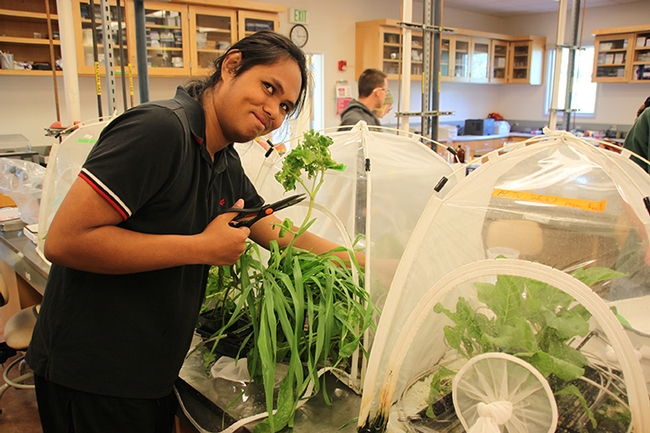


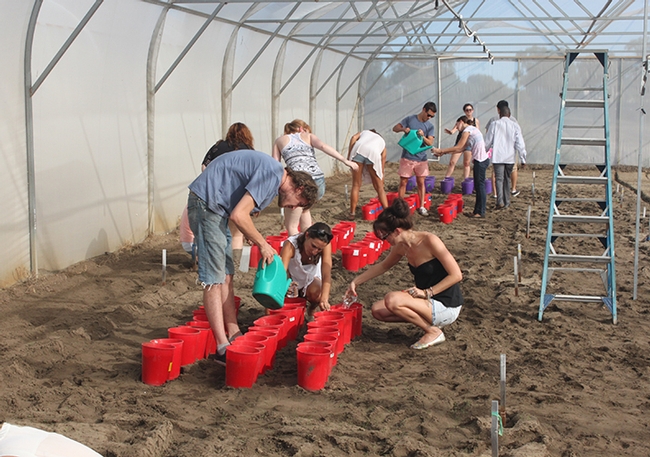
- Author: Kathy Keatley Garvey
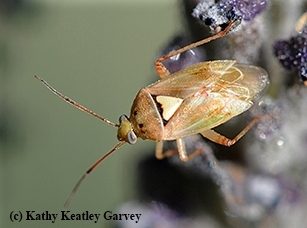
The $6000 grant is designed to support women over a two-month period in the summer as they prepare a solo-authored manuscript.
Bick's application focused on her scientific modeling work that originated from her Ph.D. program: investigating the lygus bug immigration and aggregation in California strawberries. Lygus hesperus, a serious pest of strawberries--as well as cotton, and seed crops such as alfalfa-- causes an estimated $40 million in annual losses to California's strawberry industry.
Bick's application detailed the academic women who supported her career, including one of her mentors, Cornell University entomology professor Laura Harrington. Additionally, women students she mentored while at UC Davis provided letters of support.
“Prior to receiving this good news, my fiancé, Nora Forbes, and I decided to get married in the historic home of the AAUW in St. Paul, Minn.,” Bick said. “We are both aware of AAUW's legacy of supporting women in their academic pursuits since 1881 and wanted to celebrate in a location in line with their pioneering vision.” Forbes is a statistician at the Danish Medtronic office.
Earlier this year, Bick received a $23,000 fellowship from the American Scandinavian Foundation for her proposal, "Designing Pest-Resilient Apple Orchards Using Bespoke Models." The project will start immediately following the AAUW grant.
As a postdoctoral fellow at the University of Copenhagen, the UC Davis alumnus is a member of Professor Lene Sigsgaard's research team. She received a $244,000 postdoctoral grant from the Danish Innovations Fund to estimate insect population dynamics in relation to FaunaPhotonics's LIDAR insect sensor. LIDAR stands for light detection and ranging.
Emily's entomological journey began at Cornell University, where she received her bachelor's degree in entomology in 2013. She then received two degrees in entomology from UC Davis: her master's degree in 2017 and her doctorate in 2019.
Bick, who specializes in integrated pest management, helped anchor the UC Davis Department of Entomology and Nematology's Linnaean Games Team that won the national championship at the Entomological Society of America (ESA) meeting in 2016, and the University of California (UC Davis and UC Berkeley) Linnaean Games Team that won the national championship in 2018. The Linnaean Games, launched in 1983, are lively question-and-answer, college bowl-style competitions on entomological facts and played by winners of the ESA branch competitions. The teams score points by correctly answering random questions. (Watch the championship game on YouTube).
While at UC Davis, Bick served as vice president of the UC Davis Entomology Graduate Student Association (EGSA). ESA honored her as a Board-Certified Entomologist in 2014, and the Student Certification Award in 2018. She served as an emergency medical technician from 2008 to 2017.

- Author: Kathy Keatley Garvey
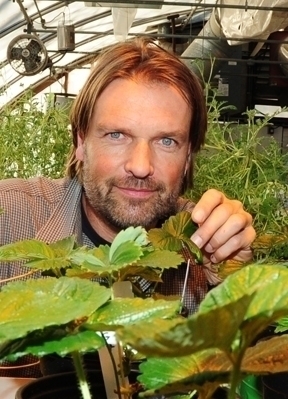
Nansen, associate professor, Department of Entomology and Nematology, is serving as the guest editor of the issue, "Remote Sensing to Detect and Diagnose Organismal Responses." The journal (impact factor 4.118) is a leading outlet for research articles and reviews on all aspects related to remote sensing.
"I'm inviting authors to submit studies that go beyond the detection of an optical reflectance response and tie a thorough analysis of remote sensing data to other types of data (physiological, molecular, genetic, biochemical)," Nansen said. "In other words, the special issue will embrace a phenomics approach, in which the overall goal is to, at least partially, explain why and how organisms exhibit an optical reflectance response to stressors and/or treatments."
As the guest editor, Nansen said he is seeking articles describing "exciting applications of remote sensing technologies to detect and diagnose differences and/or stress across all kingdoms."
Contributions are due by March 2020. For more information, access the website: https://www.mdpi.com/journal/remotesensing/special_issues/rs4organismal_response.
The UC Davis entomologist specializes in applied insect ecology, integrated pest management and remote sensing, including proximal (lab) and aerial (drone) applications of remote sensing in agriculture; and robustness and accuracy of optical classification algorithms.
Nansen, who joined the UC Davis faculty in 2014, completed his doctorate in zoology at the University of Copenhagen, Denmark. He previously held faculty positions at Texas A&M, Texas Tech, and most recently, the University of Western Australia. He may be reached at chrnansen@ucdavis.edu.
X
- Author: Kathy Keatley Garvey
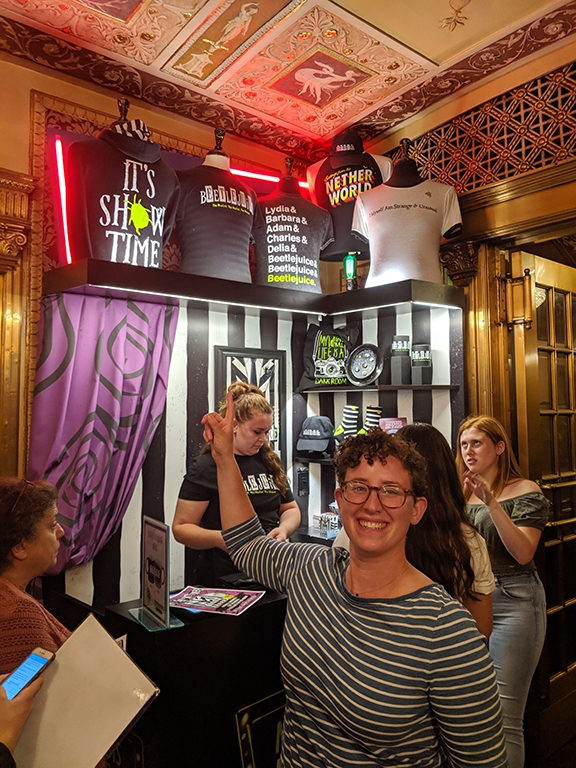
If you're the kin of Emily Bick, you take her to the Broadway stage musical, Beetlejuice, in New York City. They knew she'd be interested because (1) she's an entomologist (2) she enjoys entomology-themed shows and (3) she previously reviewed another play, “An Entomologist's Love Story,” which Entomological Society of America (ESA) published on its Entomology Today website. That piece drew rave reviews.
So, in keeping with her newly acquired “entomological theater critic credentials,” Bick reviewed Beetlejuice. Entomology Today published her piece today (Sept. 20.)
“I entered the experience knowing little about the shop but with high hopes for its entomological potential since its name appeared to reference Order Coleoptera's common name,” wrote Bick, an agricultural entomologist who will begin a postdoctoral position at the University of Copenhagen this fall.
She began with: “Like a caterpillar recently exposed to juvenile hormone, the insect-themed potential for the musical Beetlejuice was high but never quite metamorphosized.”
Bick noted there were several entomological references, including “two Scarabaeidae camouflaged within the black and white stripes” on the playbook cover.
“While writers opted for entomology appropriate spelling in both the title and song, the stage curtain listed the name as Betelgeuse,” she wrote. “This entomologically named character mentions a few throw away references to insects including describing his alarming goal of house haunting—by saying ‘frightened as a fly.'”
One character “was threatened with having teeth transformed into scorpions—an arthropod but not an insect,” Bick pointed out. “The demon-transformed house was decorated with chairs the spitting image of Tortoise beetle larvae (Coleoptera: Chrysomelidae, tribe: Cassidini) and a statue that reminded me of many immature Lepidopterans.”
“However, insect references were always used to enhance the macabre theme, rather than as an independent topic. The musical was about death, a subject of which insects have a long association with. This association is likely due to the progression of insect colonization on an animal corpse—a process so predictable, forensic entomology is often used to determine the time of death of the recently deceased. Their correlation was expanded in the era of sideshows which featured insects as bizarre. I found myself wistfully thinking of all the places insects could be used (e.g., every reference to decomposing), rather than simply propping up the ghoulish atmosphere.”
Although the show lacked insect credibility, she found the show incredible. “It was hilarious, clever, attuned to the times, and visually stunning, and the ‘goth' character Lydia (played by 18-year-old Sophia Anne Caruso) completely stole the show. Yet, judged on entomological criterion, Beetlejuice fell short of its potential.”
The Broadway stage musical is based on the film, Beetlejuice, the 1988 American fantasy-comedy-horror film directed by Tim Burton (Pee Wee's Big Adventure). It is about "a deceased couple who try to haunt the new inhabitants of their former home and call for help from a devious bio-exorcist ghost named Betelgeuse (pronounced "Beetlejuice"), who is summoned by saying his name three times," according to Wikipedia.
Bick holds three degrees in entomology: a bachelor's degree from Cornell University, Ithaca, N.Y., and a master's degree and doctorate from UC Davis. She is a Board Certified Entomologist (with specialties in plant-insect and medical and veterinary entomology), awarded by ESA. While at UC Davis, she was active in the Linnaean Games and helped two teams win national championships. ESA describes the Linnaean Games as "a lively question-and-answer, college bowl-style competition on entomological facts played between university-sponsored student teams."
(Entomologist-theatre critic Bick may be reached at enb@plen.ku.dk.)
